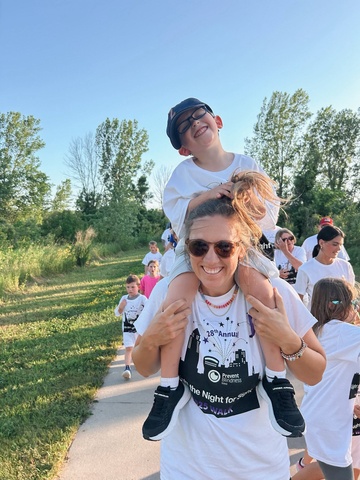During Zander Raisch’s routine newborn screening in 2021, the hospital pediatrician noted that he couldn’t find Zander’s “red reflex,” a reddish-orange glow observed when light reflects off the retina. Zander was immediately referred to Wolfe Eye Clinic in Des Moines.
When he was 6 days old, Zander was diagnosed with dense bilateral congenital cataracts. His parents, Amanda and Cody, were told that if the cataracts weren’t removed, his vision would not likely develop.
At 6 weeks old, Zander had his first surgery to remove the cataract in one eye, followed by cataract surgery in the other eye two weeks later. After these surgeries, Zander was considered “aphakic,” which means his eyes are missing the natural lens of the eye, a major part of the focusing system for seeing both far and near.

When he was 10 weeks old, Zander received his first set of specialized contact lenses. Amanda says those were preferable because wearing glasses at that age made the development of peripheral vision more difficult.
Although Zander’s cataracts had been removed, he wasn’t out of the woods when it came to vision loss. About half of children who undergo congenital cataract surgery develop glaucoma, a leading cause of irreversible vision loss.
Because of that risk, Zander had to be seen at the eye doctor every two to three months to have his eye pressures checked.
“Normal eyes produce fluid and drain on their own,” Amanda says. “When the fluid doesn’t drain properly, pressures are increased leading to glaucoma and visual damage.”
Zander was diagnosed with ocular hypertension in his left eye due to elevated pressure, with the hope that it could be managed with prescription eye drops. But by 2024, he had been diagnosed with glaucoma in the left eye and had to have surgery.
In April 2025, Zander had his third eye surgery at University of Iowa Health Care-University Campus. The glaucoma tube shunt surgery, conducted by Dr. Erin Boese, utilized corneal tissue recovered, evaluated, and distributed by Iowa Lions Eye Bank.
Boese says tube shunt implants require donor tissue to protect it from infection and erosion.
“The tissue allows the implant to be better incorporated,” Boese says “While other donor tissues can be used to cover the implant like sclera or pericardium, cornea donor grafts are preferred as they are both durable and have the best cosmetic results.”
Each year, thanks to the generosity of cornea donors and their families, Iowa Lions Eye Bank provides tissue for hundreds of glaucoma shunt surgery patients like Zander.
Amanda says she and her family are “forever in awe” of the medical team, and grateful for Zander’s vision team at Wolfe Eye Clinic in Des Moines and the University of Iowa Department of Ophthalmology and Visual Sciences in Iowa City.
“I will never take for granted a ‘mom, look at this’ or a ‘mom, watch me’ — the gift of sight is so beautiful,” Amanda says.
